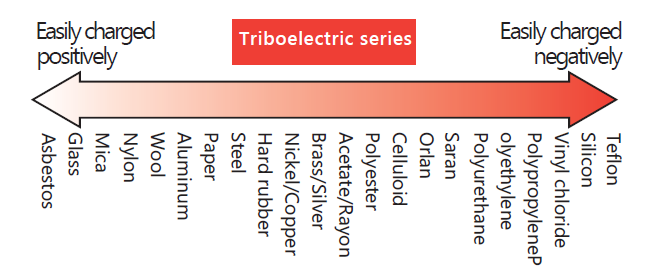Control Panel Cooling units Technical Information
3-7. Basics of static electricity
(1) Static electricity brings various harmful effects to work.
Proper humidity control can prevent the generation of static electricity.
Static electricity often makes us feel uncomfortable in winter, but this is not the only harmful effect of static electricity.
In the manufacturing industry, it can cause particularly serious failures in processes and products.
There is an image that static electricity occurs more often in winter when the air is dry, but in reality, it occurs all around us regardless of the season.
Static electricity is caused by a combination of several conditions, the most important of which is "humidity".
In this chapter, we will explain the relationship between static electricity and humidity, and introduce methods for controlling humidity to suppress the generation of static electricity.
(2) Basics of static electricity
Static electricity can cause product destruction, equipment trouble, fire and explosion.
Static electricity and electrification
Static electricity is the state in which an object is charged or the electricity (electric charge) itself that is charged.
In addition, electrification means that an object can be electrically positive or negative, and depending on the substance, there are those that are easily charged positively and those that are easily charged negatively.
The order of substances that are easily electrified is called a "triboelectric series".
When two substances in the triboelectric series are rubbed together, the positive side tends to become positively charged, and the negative side tends to become negatively charged.
Also, it is known that the static electricity generated is greater the further apart the two substances are in the row.
Status of static electricity generation
There are three types of static electricity: "peeling electrification", "frictional electrification" and "contact electrification".
| Type | Reason for occurrence | Example |
|---|---|---|
| Peeling electrification | Occurs when two overlapping objects separate. | Occurs when peeling off overlapping films. |
| Frictional electrification | Occurs when two objects rub or touch. | Static electricity is generated when taking off clothes. |
| Contact electrification | Occurs when things come into contact with each other. | Electrostatic discharge shock in winter. |
Adverse effects of static electricity in production sites and evaluation environments
Unintentional generation of static electricity causes various problems in production sites and evaluation environments.
| Item | Contents |
|---|---|
| Adhesion of dust | Static electricity is generated, and dust and dirt adhere to the product. |
| Electrostatic breakdown | The product is destroyed by the discharge phenomenon of charged static electricity. |
| Painting print defect | Static electricity causes unevenness in painting and printing. |
| Decrease in production efficiency | The film sticks to the equipment and clogs the feeder, reducing production efficiency. In addition, noise is generated, which may cause equipment to malfunction. |
| Ignition | Fires and explosions can occur due to electrostatic discharge. |
| Electric schock secondary disaster | Occurrence of secondary disasters (workers being surprised and dropping objects, slipping, etc.) due to electrostatic discharge shocks. |
Previous item: 3-6. Relationship between electrical resistance and temperature
Next item: 3-8. Relationship between static electricity and humidity
We're here to give you quick answers to your questions.

